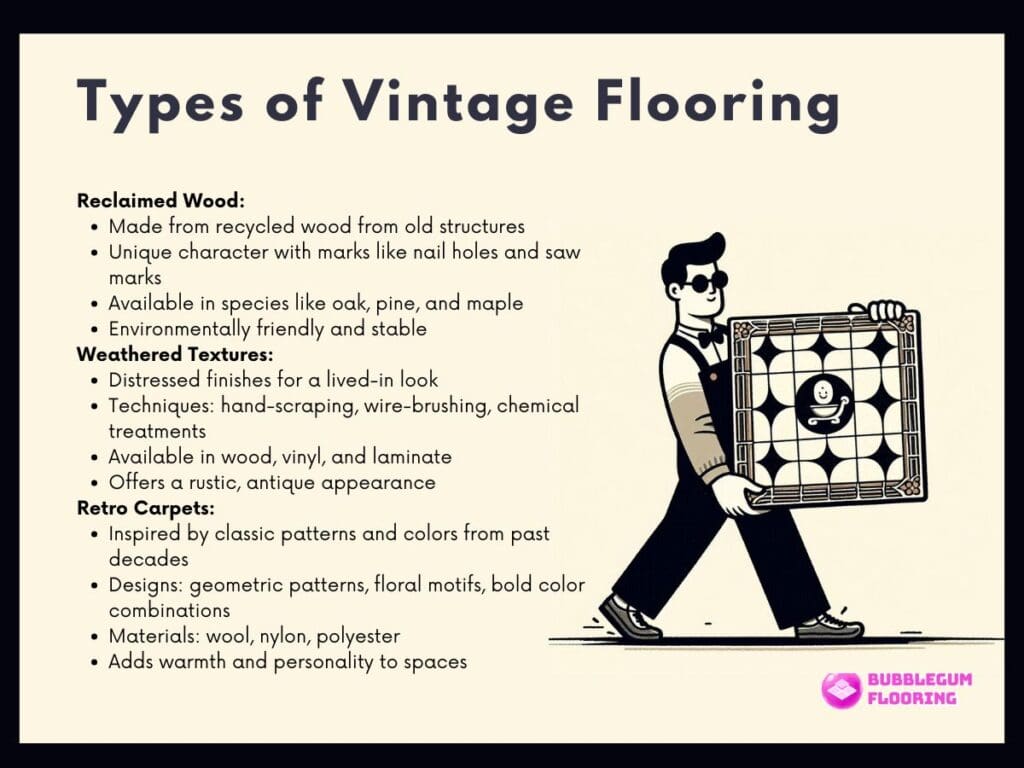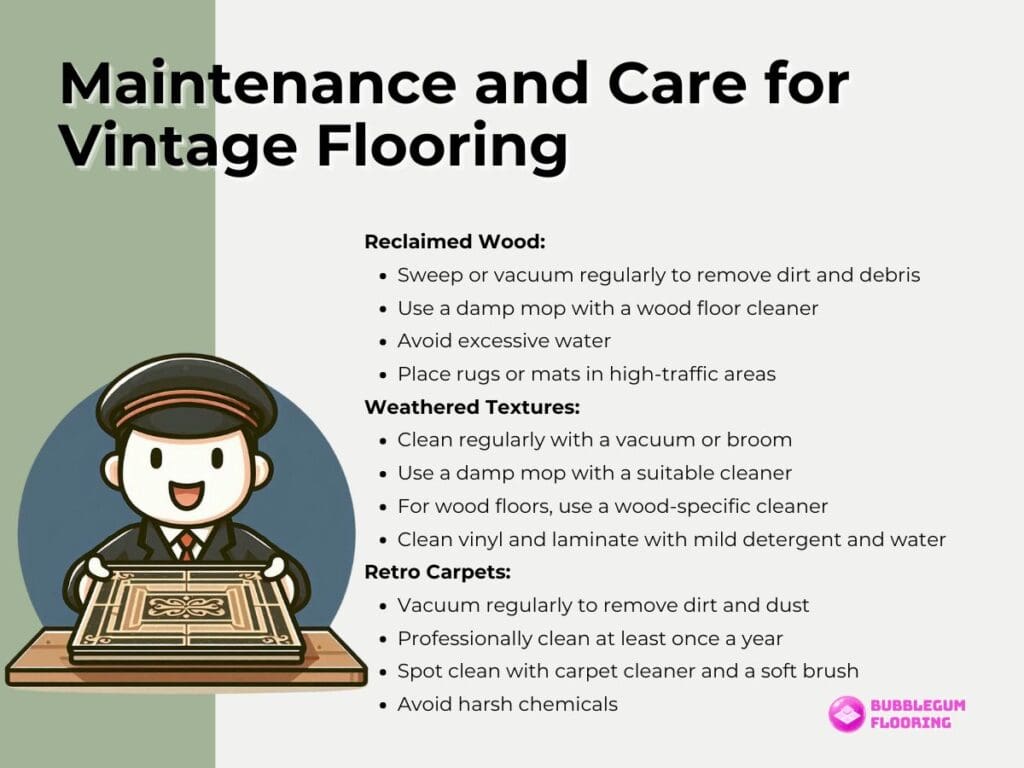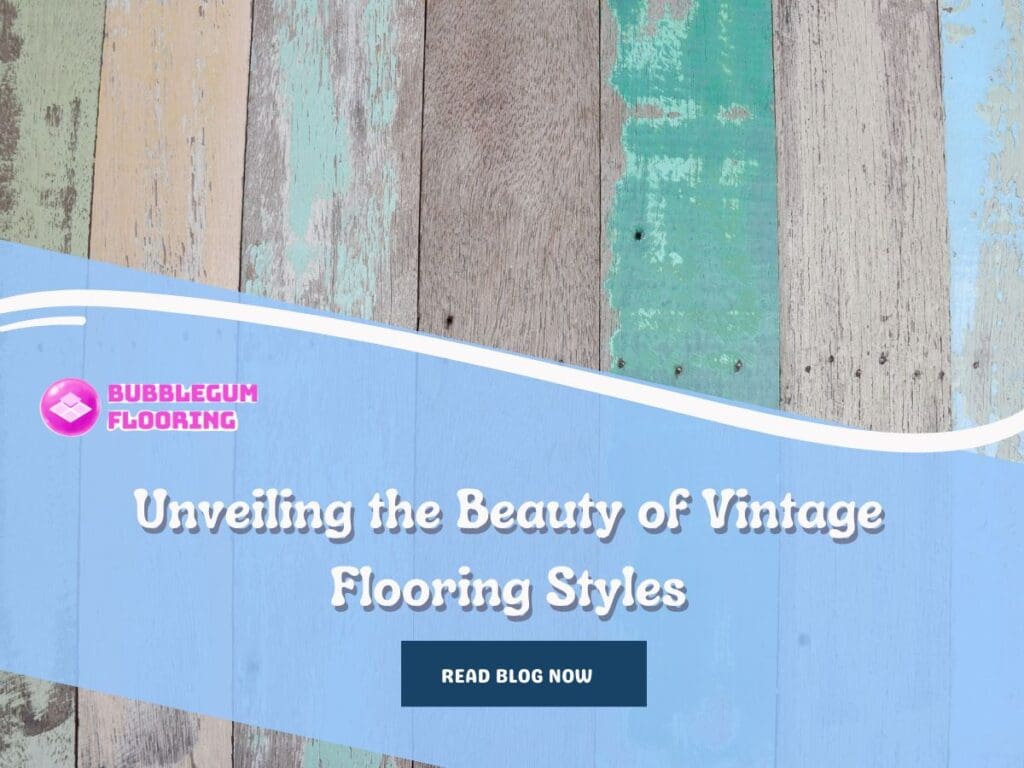Vintage flooring styles bring a timeless elegance and unique character to any space. By incorporating reclaimed wood, weathered textures, and retro carpets, homeowners can create interiors that tell a story, blending the charm of the past with modern comforts. These flooring options not only offer a distinctive look but also contribute to sustainable design practices.
From the rustic appeal of reclaimed wood to the nostalgic patterns of retro carpets, vintage flooring styles provide endless possibilities for creating beautiful, inviting spaces. Discover how these timeless designs can transform your home, adding warmth, personality, and a touch of history. Let’s look into unveiling the beauty of vintage flooring styles.
Types of Vintage Flooring
Vintage flooring offers a timeless charm and a unique aesthetic appeal that modern floors often lack. These flooring types are not only beautiful but also add character and a sense of history to any space. Here are some popular types of vintage flooring:

Reclaimed Wood
Reclaimed wood flooring is made from recycled wood sourced from old barns, factories, and warehouses. This type of flooring is highly sought after due to its rich history and unique character. The wood often bears the marks of its previous use, such as nail holes, saw marks, and other imperfections, which add to its charm. Reclaimed wood floors are available in various species, including oak, pine, and maple, each offering different hues and grain patterns.
Reclaimed wood is also an environmentally friendly option. By using recycled materials, it reduces the demand for new timber, thereby contributing to forest conservation. Additionally, reclaimed wood flooring tends to be more stable than new wood, as it has already undergone the natural expansion and contraction process over time.
Weathered Textures
Weathered textures in flooring evoke a sense of lived-in charm and nostalgia. This type of flooring is characterized by its distressed finishes, which simulate the wear and tear that naturally occurs over time. The weathered look can be achieved through various techniques, including hand-scraping, wire-brushing, and chemical treatments.
Weathered textures are available in several materials, such as wood, vinyl, and laminate. Each material offers different advantages, but they all share the common goal of providing a rustic, antique appearance. Weathered wood floors, for example, can feature rough, uneven surfaces and visible knots, creating an authentic vintage feel. On the other hand, weathered vinyl or laminate floors offer the same aesthetic with added durability and ease of maintenance.
Retro Carpets
Retro carpets bring a touch of vintage elegance to any room. These carpets are inspired by classic patterns and colorways from past decades, blending traditional and modern styles seamlessly. Popular retro carpet designs include geometric patterns, floral motifs, and bold color combinations reminiscent of the mid-20th century.
Retro carpets are available in various materials, such as wool, nylon, and polyester. Wool carpets, for instance, offer a luxurious feel and excellent durability, while synthetic fibers like nylon and polyester are more affordable and stain-resistant. Regardless of the material, retro carpets can instantly transform a space, adding warmth and personality.
Applications of Vintage Flooring
Vintage flooring can be used in various applications to create unique, inviting spaces. Here are some ideas for incorporating vintage flooring into different rooms:
Living Room
The living room is an ideal space to showcase vintage flooring, as it is often the focal point of the home. Using vintage rugs and antique furniture, you can create a harmonious blend of old and new.
For instance, a reclaimed wood floor can be complemented with a Persian rug, vintage coffee table, and modern sofa. The combination of textures and styles adds depth and interest to the room, making it a cozy and welcoming space.
Bedroom
The bedroom is another perfect setting for vintage flooring. Pairing modern furniture with vintage elements can create a serene and stylish retreat. For example, a weathered wood floor can be paired with a sleek, contemporary bed and antique chests or ornate headboards. The mix of old and new elements creates a balanced and inviting atmosphere, ideal for relaxation.
Retro carpets can be used to add a touch of vintage charm to the bedroom. A carpet with a bold geometric pattern or classic floral design can serve as a focal point, enhancing the overall aesthetic of the room. The soft texture of the carpet also adds warmth and comfort, making the bedroom a cozy haven.
Bathroom
The bathroom is often overlooked when it comes to vintage flooring, but it can be a great space to experiment with different styles. Installing freestanding clawfoot tubs and contrasting them with sleek chrome fittings can create a striking visual effect. For example, a reclaimed wood floor can be paired with a clawfoot tub and modern fixtures, creating a unique blend of old-world charm and contemporary elegance.
Another option is to use vintage-inspired tiles in the bathroom. Retro tiles with classic patterns and colors can add a touch of nostalgia and sophistication to the space. These tiles can be used on the floor, walls, or even as a backsplash, creating a cohesive and stylish look.
Maintenance and Care for Vintage Flooring
Proper maintenance and care are essential to preserve the beauty and longevity of vintage flooring. Each type of vintage flooring requires specific care methods to keep it looking its best.

Reclaimed Wood
Reclaimed wood floors should be regularly swept or vacuumed to remove dirt and debris that can cause scratches. It is also important to use a damp mop with a wood floor cleaner to keep the surface clean and conditioned.
Avoid using excessive water, as it can damage the wood. Additionally, placing rugs or mats in high-traffic areas can help protect the floor from wear and tear.
Weathered Textures
Weathered texture floors, whether wood, vinyl, or laminate, should be cleaned regularly to maintain their appearance. Use a vacuum or broom to remove dust and dirt, and a damp mop with a suitable cleaner for deeper cleaning.
For wood floors, it is important to use a cleaner specifically designed for wood to avoid damaging the finish. Vinyl and laminate floors can be cleaned with a mild detergent and water solution.
Retro Carpets
Retro carpets require regular vacuuming to remove dirt and dust. For deeper cleaning, it is recommended to have the carpets professionally cleaned at least once a year. Spot cleaning can also be done using a carpet cleaner and a soft brush. Avoid using harsh chemicals, as they can damage the fibers and colors of the carpet.
Benefits of Vintage Flooring
Vintage flooring offers several benefits that make it an attractive choice for many homeowners and designers. Here are some of the key advantages:
- Timeless Aesthetic: Vintage flooring brings a classic and timeless look to any space. Its unique patterns, textures, and colors can add character and charm that modern flooring options often lack.
- Durability: Many vintage flooring options, especially hardwood and stone, were crafted from high-quality materials and have stood the test of time. This makes them highly durable and capable of lasting for many more years with proper care.
- Eco-Friendly: Using vintage flooring is an environmentally friendly choice. It reduces the demand for new materials and helps preserve natural resources. Reusing existing materials also minimizes waste and the environmental impact associated with manufacturing new products.
- Unique Character: Each piece of vintage flooring has its own history and unique characteristics. This individuality adds a distinctive touch to your home that is impossible to replicate with new materials.
- Increased Property Value: Vintage flooring can enhance the value of your property. Its timeless appeal and durability make it an attractive feature for potential buyers, potentially leading to a higher resale value.
- Versatility: Vintage flooring works well with various interior design styles, from rustic and traditional to modern and eclectic. It can be used in different rooms and settings, providing a versatile solution for many design needs.
- Quality Craftsmanship: Older flooring often reflects superior craftsmanship, with intricate designs and meticulous attention to detail. This quality can add a sense of luxury and refinement to your space.
- Cost-Effective: In some cases, vintage flooring can be more cost-effective than new, high-end flooring options. While the initial cost might be higher, the longevity and minimal maintenance requirements can result in long-term savings.
- Easy Maintenance: Many vintage flooring options, particularly those made from natural materials, are relatively easy to maintain. With regular cleaning and occasional refinishing, they can continue to look beautiful for years.
Challenges and Considerations
While vintage flooring offers numerous benefits, it also comes with its own set of challenges and considerations. Proper care, maintenance, and installation are crucial to ensuring that your vintage flooring remains beautiful and functional for years to come. Here are some key challenges and considerations to keep in mind:
Maintenance
Vintage flooring requires regular maintenance to preserve its appearance and durability. Reclaimed wood, weathered textures, and retro carpets all need specific care to keep them looking their best. For reclaimed wood floors, it is essential to regularly sweep or vacuum to remove dirt and debris that can cause scratches. Using a damp mop with a wood floor cleaner helps keep the surface clean and conditioned, but excessive water should be avoided to prevent damage.
Weathered texture floors, whether wood, vinyl, or laminate, also need regular cleaning to maintain their appearance. Vacuuming or sweeping to remove dust and dirt, followed by damp mopping with an appropriate cleaner, can help preserve the floor’s beauty.
Retro carpets require regular vacuuming and periodic professional cleaning to remove deep-seated dirt and stains. Spot cleaning with a carpet cleaner and a soft brush can address spills and stains, but harsh chemicals should be avoided to prevent damage to the fibers.
Humidity Control
Managing humidity levels is crucial for vintage flooring, especially for reclaimed wood and other natural materials. Wood is hygroscopic, meaning it absorbs and releases moisture depending on the surrounding humidity levels. Excessive moisture can cause the wood to swell, warp, or buckle, while low humidity can lead to shrinking and cracking.
To prevent damage from moisture, it is important to maintain a consistent indoor humidity level, ideally between 30% and 50%. Using a humidifier during dry seasons and a dehumidifier during humid seasons can help regulate indoor humidity levels. Additionally, installing a moisture barrier under the flooring can provide extra protection against moisture-related issues.
Installation
Installing vintage flooring can be more complex than installing new, modern materials. Reclaimed wood, for example, often comes in varying sizes, shapes, and conditions, which can make the installation process more challenging. Specialized installation techniques and tools may be required to ensure proper alignment, stability, and a seamless appearance.
Weathered textures and retro carpets also require careful installation to achieve the desired look and ensure durability. For weathered wood floors, it is important to select a professional installer experienced in handling distressed materials. Retro carpets, especially those with intricate patterns, need precise installation to align the patterns correctly and avoid visible seams.
Vintage flooring may require acclimation before installation. This involves allowing the flooring materials to adjust to the indoor environment for a specified period, usually a few days, to minimize expansion or contraction after installation.
Conclusion
Unveiling the beauty of vintage flooring styles reveals a world of timeless charm and sustainable design. Reclaimed wood, weathered textures, and retro carpets each offer unique aesthetics and stories, enriching any space with character and history. While these flooring options require thoughtful maintenance and installation, the results are worth the effort.
Vintage flooring not only enhances the visual appeal of your home but also fosters a sense of connection to the past. Embrace these classic styles to create inviting, memorable spaces that stand the test of time, reflecting both your personal style and commitment to sustainability.


